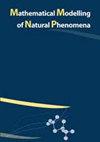Adaptation of an asexual population with environmental changes
IF 2.1
4区 数学
Q2 MATHEMATICAL & COMPUTATIONAL BIOLOGY
引用次数: 1
Abstract
Because of mutations and selection, pathogens can manage to resist to drugs. However, the evolution of an asexual population (e.g., viruses, bacteria and cancer cells) depends on some external factors (e.g., antibiotic concentrations), and so understanding the impact of the environmental changes is an important issue. This paper is devoted to model this problem with a nonlocal diffusion PDE, describing the dynamics of such a phenotypically structured population, in a changing environment. The large-time behaviour of this model, with particular forms of environmental changes (linear or periodically fluctuations), has been previously developed. A new mathematical approach (limited to isotropic mutations) has been developed recently for this problem, considering a very general form of environmental variations, and giving an analytic description of the full trajectories of adaptation. However, recent studies have shown that an anisotropic mutation kernel can change the evolutionary dynamics of the population: some evolutive plateaus can appear. Thus the aim of this paper is to mix the two previous studies, with an anisotropic mutation kernel, and a changing environment. The main idea is to study a multivariate distribution of (2n) "fitness components". Its generating function solves a transport equation, and describes the distribution of fitness at any time.无性种群对环境变化的适应
由于突变和选择,病原体可以设法抵抗药物。然而,无性种群(如病毒、细菌和癌细胞)的进化取决于一些外部因素(如抗生素浓度),因此了解环境变化的影响是一个重要问题。本文致力于用非局部扩散PDE模型来描述这种表型结构种群在不断变化的环境中的动态。该模型的大时间行为,以及特定形式的环境变化(线性或周期性波动),以前已经得到了发展。最近,一种新的数学方法(仅限于各向同性突变)已经发展起来,考虑到环境变化的一种非常普遍的形式,并给出了适应的完整轨迹的分析描述。然而,最近的研究表明,各向异性突变核可以改变种群的进化动态,可能出现一些进化高原。因此,本文的目的是在各向异性突变核和不断变化的环境下,将这两种研究相结合。主要思想是研究(2n)的多元分布“健身组件”。它的生成函数求解一个输运方程,描述任意时刻的适应度分布。
本文章由计算机程序翻译,如有差异,请以英文原文为准。
求助全文
约1分钟内获得全文
求助全文
来源期刊

Mathematical Modelling of Natural Phenomena
MATHEMATICAL & COMPUTATIONAL BIOLOGY-MATHEMATICS, INTERDISCIPLINARY APPLICATIONS
CiteScore
5.20
自引率
0.00%
发文量
46
审稿时长
6-12 weeks
期刊介绍:
The Mathematical Modelling of Natural Phenomena (MMNP) is an international research journal, which publishes top-level original and review papers, short communications and proceedings on mathematical modelling in biology, medicine, chemistry, physics, and other areas. The scope of the journal is devoted to mathematical modelling with sufficiently advanced model, and the works studying mainly the existence and stability of stationary points of ODE systems are not considered. The scope of the journal also includes applied mathematics and mathematical analysis in the context of its applications to the real world problems. The journal is essentially functioning on the basis of topical issues representing active areas of research. Each topical issue has its own editorial board. The authors are invited to submit papers to the announced issues or to suggest new issues.
Journal publishes research articles and reviews within the whole field of mathematical modelling, and it will continue to provide information on the latest trends and developments in this ever-expanding subject.
 求助内容:
求助内容: 应助结果提醒方式:
应助结果提醒方式:


